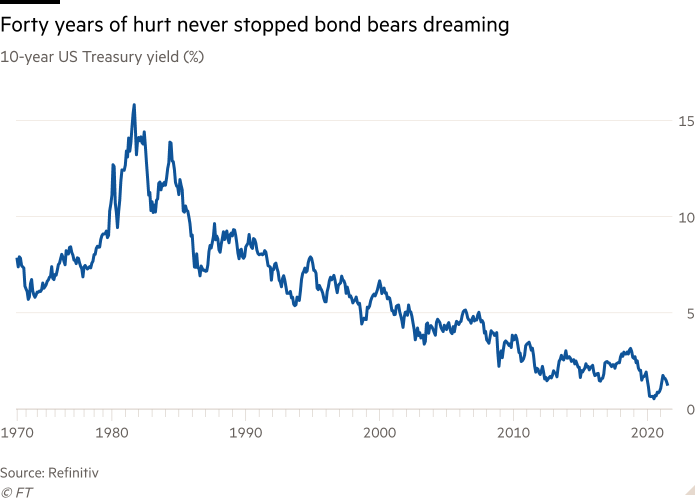A humbling week for bond bears
Towards the end of January, UBS asked the question that mattered most for global markets: “Bond bears come out of hibernation, but is it too soon?”
Hibernation was possibly not the right word. Strong demand and sinking benchmark interest rates meant that yields on US government bonds, the centre of markets’ universe, had been sliding pretty smoothly for close to 40 years. So, less a case of waking from a winter snooze, more a case of the resurgent undead.
In any case, six months or so later, investors appear to have decided it was indeed too soon. The Great Bond Wobble of 2021 was striking — the benchmark 10-year US government bond yield rattled as high as 1.77 per cent in late March, and the first quarter was the darkest for the market in four decades. But this week brought an abrupt rethink, leaving yields as low as 1.25 per cent, still well above the starting point of the year, but a serious dent.
It is worth reliving some of the bond shock’s origins and key moments.
Their safety and stability mean that government bonds love misery (among other things). So when news about vaccine rollouts late last year dangled the tantalising prospect of a return to post-pandemic normal life for the first time, that dragged them down.
The real blow however came from the spectre of inflation, the market’s true kryptonite as it eats into the fixed rate of bond returns. The Democratic party’s success in clinching control of the US Senate with an early January win in Georgia fired up expectations for supercharged fiscal spending. A powerful accepted wisdom developed of persistently surging growth, lasting fiscal support and a Federal Reserve that would turn a blind eye to rising price pressures.
“The narrative in January was pie in the sky, it was rainbows and fairy dust,” said James Athey, an investment manager at abrdn, the asset manager that inexplicably changed its name this week from Aberdeen Standard Investments. (For anyone wondering, it is pronounced “Aberdeen”. I don’t get it either.)
In that environment, a shaky auction of seven-year US government debt in February — typically a humdrum event that would captivate only the purists — ended up sparking a heavy drop. Ten-year yields finished the day some 0.14 percentage points higher, a huge move by the standards of the typically sedate US market.
That served as a reminder that while US government bonds are the bedrock of global markets, underpinning the price of pretty much all riskier asset classes around the world, they have their moments of instability under pressure. That is a faultline that might be tested when the Fed more forcefully reels back its largesse.

Even Steven Major, HSBC’s head of bond research and one of the best-known and most bullish voices on the street, said in February he was “eating humble pie”. Around that time, Major bumped up his year-end forecast for 10-year yields by a quarter of a percentage point.
Now, though, as Athey notes, investors are scaling back some of the more generous expectations around fiscal spending. Inflation has picked up, sharply, but investors are increasingly confident that much of it appears rooted in the bottlenecks inevitable in an economy emerging quickly from lockdowns. And crucially, the Fed has reinforced the message that its somewhat more relaxed attitude to rising prices in the post-crisis recovery does not mean it has abandoned its inflation-targeting mandate altogether. Rate setters have indicated that lift-off in policy rates may come somewhat sooner than they had previously anticipated.
The result is a 0.19 percentage-point drop in 10-year yields to the lowest point of last week, albeit with a small rebound on Friday.
One mystery here is precisely what sparked the rush back in to bonds. Some of the supposed underlying reasons have been kicking around for a few weeks with much more limited effect.
Perhaps the most popular explanation is positioning: investors’ consensus had become so strong and the reflation trade too popular. When this positioning started to unravel, the resulting pick-up in bond prices tripped up investors that were still short. These sorts of squeezes can quickly become self-reinforcing.
Major, who is sticking to his 1 per cent 10-year yield target for the end of the year is not convinced on that front. “Positioning is ex-post rationalisation,” he said. “It’s a little bit intellectually bankrupt.”
But he suggests that investors should think again about the real drivers of demand for government bonds even at times of enormous issuance. “You can flip them in to cash without even moving the price. That’s true liquidity,” he said. “Can you do that with your house? Can you do it with crypto?”
So what next? Naturally, it takes two sides to make a market. UBS Wealth Management said this week that it still expects yields to reach 2 per cent this year, while the BlackRock Investment Institute is also shying away from government bonds on the basis that skinny yields offer little cushion to compensate against shocks elsewhere in a portfolio.
Major, too, thinks the pick-up in bond prices is largely over for the time being. But he adds: “We’re not going short, and we haven’t changed our forecasts. We have still got half a year to go.”
For all the latest Business News Click Here
For the latest news and updates, follow us on Google News.
